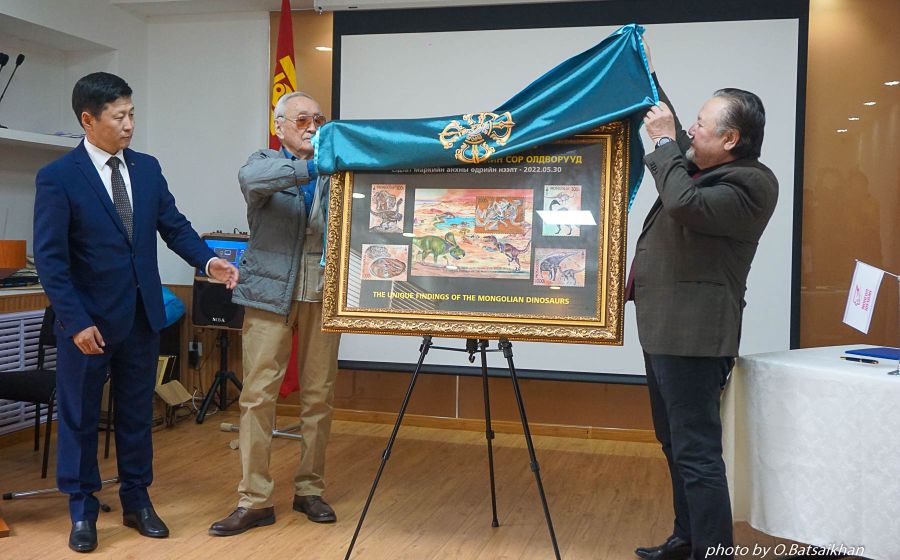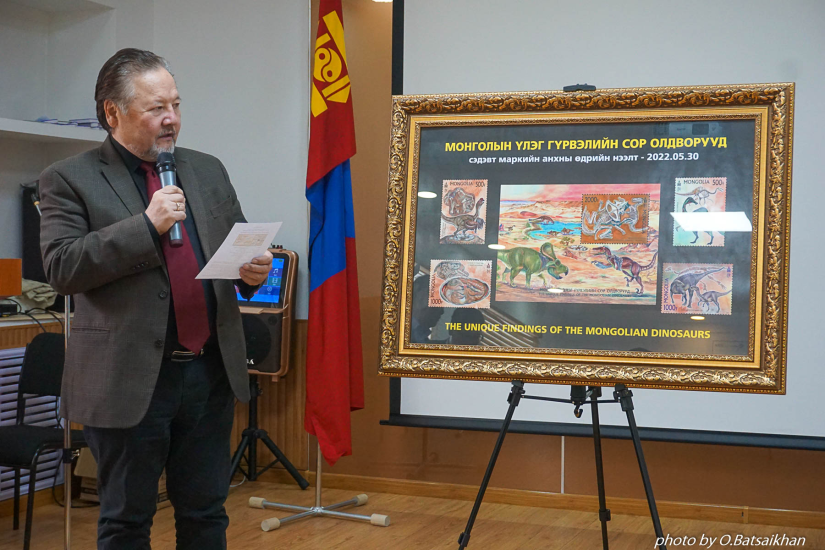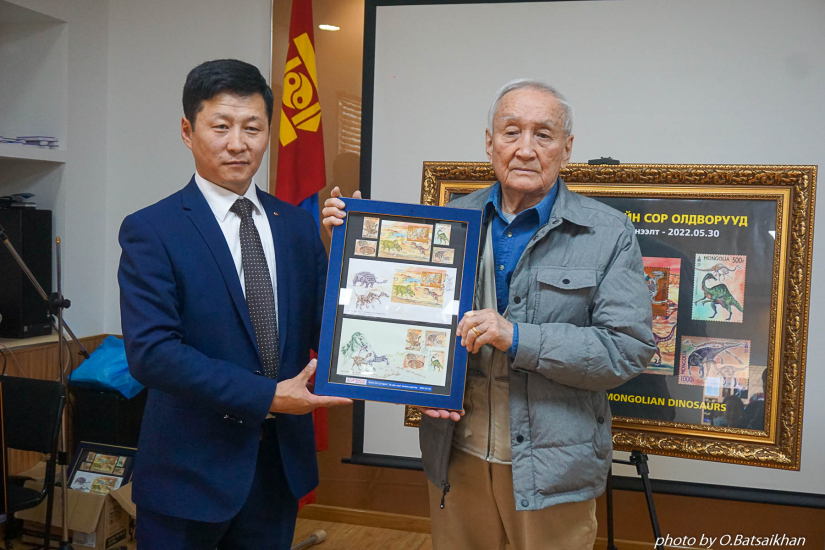Mongolia 2022 "The Unique Discoveries Of The Mongolian Dinosaurs"
| <prev | back to index | next> |
| Issue Date | 30.05.2022 |
| ID | Michel: Scott: 2993-2997, Stanley Gibbons: , Category: pR |
| Desiners |
Stamp artist: B. Bayarchuu, Stamp designer: J. Gankhuyag |
| Stamps in set | 4 + 1 |
| Value |
500 MNT - Citipatiincubating its eggs 500 MNT - Deinocheirus mirificus 1000 MNT - Embryo of Citipati osmolskae 1000 MNT - Gobihadros mongoliensis 2000 MNT - The Fighting Dinosaurs |
| Size (width x height) | Stamp size: 33mm x 45mm, Souvenir-Sheet size: 110 x 80mm |
| Layout | 4 Sheets of 10 stamps, Souvenir-Sheet with 1 stamp |
| Products | FDC x 2 |
| Paper | |
| Perforation | 14x13.75, 13.75x14, (available as imperforate too) |
| Print Technique | Offset 4 colors |
| Printed by | |
| Quantity | stamp sets: 20.800, Souvenir-Sheets: 11.000, FDC sets: 1.100 |
| Issuing Authority | Mongol Post Company |
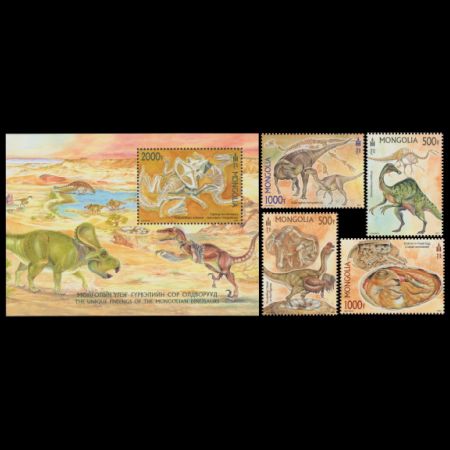
On May 30th 2022, the Post Authority of Mongolia issued set of 4 stamps and a Souvenir Sheet "The Unique Discoveries Of The Mongolian Dinosaurs". These stamps and FDC were sold out in the on-line store of Mongolian Post during the day of issue.
Every stamp shows one unique fossil found in Mongolia and reconstruction of the animal. The Souvenir-Sheet shows an entire scene of prehistoric life on the territory of Mongolia, with many dinosaurs on the margin.
The first day ceremony was hosted at the Institute of Paleontology of the Mongolian Academy of Sciences (MAS) in Ulan Bataar. At the ceremony, the Director of the Institute, Dr. Khishigjav Tsogtbaatar, Academician Rinchen Barsbold, and the Post of Mongolia Department Head, S. Ulziitseren discussed how the stamps were created and the professional advice that was used to design the images on the stamps.
The stamp shows fossils and reconstructions of some world-famous dinosaurs unearthed in Mongolia. All Mongolian Dinosaurs were discovered in the Gobi desert.
The Mongolian Gobi Desert is one of the largest dinosaur fossil reservoir in the world.
The region is especially important as regards dinosaur fossils from the later Cretaceous period,
which is the last of main three periods of the dinosaur age, representing the final phase of dinosaur evolution.
Paleontologists still continue to discover fossils that prove the current territory of Gobi Desert had a very
different climate and environment before 120 to 70 million years ago, during the Cretaceous period.
Over a history of over 100 years of dinosaur research, more than 80 genera of dinosaurs have been found
in the Mongolian Gobi Desert and identified in science as individual groups, and over 60 fossil sites of
dinosaurs and other vertebrates are being discovered by their spato-temporal distribution
(from the earlier ages until late) across the Gobi Desert.
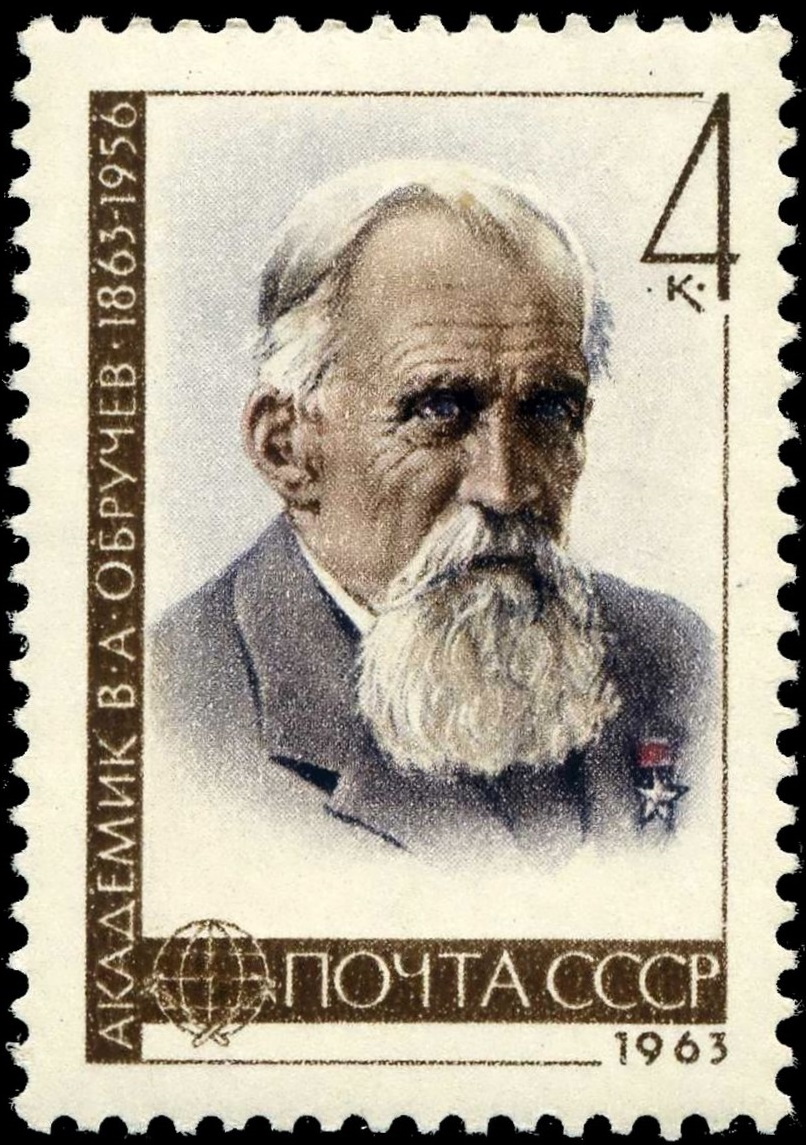 |
| Vladimir Afanasyevich Obruchev on stamp of USSR 1963, MiNr.: 2807, Scott: 2714. |
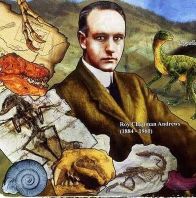 |
| Roy Chapman Andrews on stamp of Comoros Islands 2009, MiNr.: 1966, Scott: 1044a. |
The history of paleontological research in Mongolia began in 1892, when Russian geologist
Vladimir Afanasyevich Obruchev found on the border Inner and Outer Mongolia tooth of a Tertiary rhinoceros.
Based on this discovery academician Aleksej Alekseevich Borisyak, founder and first director of the Paleontological institute in Moscow,
suggested in 1915 that tertiary strata of Mongolia is similar to the strata in
Kazakhstan, from where at that time the remains of various
prehistoric mammals were known.
Therefore, there appeared the possibility of discovering in Mongolia fossil faunas close to Kazakh.
These prognoses motivated the Central Asiatic Expedition of the American Museum of
Natural History (AMNH) in the 1920s, leaded by one of the most famous American paleontologists and fossils hunter
Mr. Roy Chapman Andrews.
The expedition found fossils of Late Cretaceous vertebrates (Protocerntops, small carnivorous
dinosaurs, clutches of dinosaur eggs, mammals) at the Bayan Zag site in Southern Mongolia and Early
Cretaceous dinosaurs (Psittncosnurus) and fishes in the Andai Khudag and
Öösh sites in the Lakes Valley of Central Mongolia.
The Andrews's expedition also discovered the Palaeocene Gashato site near Bayan Zag and the
Oligocene Ardyn Ovoo (= Ergil Ovoo,=Ergiliin Zoo) site in south-eastern Mongolia and
the Tatal Gol site in the Lakes Valley, where they discovered many new Paleogene mammals.
One of the most famous discoveries of the expedition came at a locality called the Flaming Cliffs (Bayn Dzak); it was here that the first universally
recognized dinosaur eggs were found.
(The first scientifically documented dinosaur egg fossils were discovered in southern France by a Catholic
priest and amateur naturalist named Father Jean-Jacques Pouech in 1859.
Poech mistook them, however, for the shell of a giant bird's eggs.)
These eggs were mistakenly attributed to the locally abundant herbivore Protoceratops, but are now known to be Oviraptor eggs.
In 1924, a communist regime was installed in Mongolia with the support of the Soviet Union.
This regime persisted in Mongolia to the early 1990s.
During this interval, American and other Western paleontological expeditions were not welcome in Mongolia.
Instead, several joint expeditions were sponsored by Mongolia and the Warsaw Pact countries -
with prominent expeditions co-sponsored with the Soviet Union and Poland between the 1940s and 1970s.
These expeditions made many important paleontological discoveries including many new dinosaur fossils.
In 1947 for example, the Second Soviet-Mongolian paleontologic expedition to the Gobi Desert discovered
complete skeletons of Tarbasausrus and Saurolophus
with preserved fossilized skin.
Many dinosaur fossils were discovered by the Mongolian-Polish paleontological expeditions between 1963 and 1971.
These expeditions also found several fossils of primitive mammals.
Some of the dinosaurs discovered during these expeditions were depicted on the
Polish stamps of 2000.
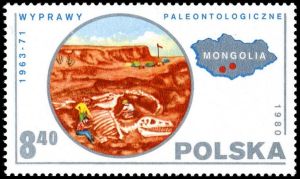 |
| Tarbosaur fossil excavation by Polish and Mongolian paleontologist in the Gobi desert on s tamp of Poland 1980, MiNr.: 2691, Scott : 2395. |
American and Canadian paleontological expeditions were allowed to return to Mongolia in the early 1990s,
shortly after the collapse of the communist regime.
Many Mongolian dinosaur fossils are on display in
paleontological museums of
Russia,
Poland,
the USA and
Mongolia.
Mongolia recognizes the significance of their fossil resources - and has worked with other countries to repatriate
Mongolian fossils back to Mongolia.
Mongolia continues to work against smugglers who illegally obtain and sell Mongolian dinosaurs abroad.
The "Tarbasausrus Bataar" stamps set of Mongolia 2014 was issued
to celebrate return of nearly complete Tyrannosaurus bataar from the USA.
The skeleton was returned to Mongolia following the high-profile prosecution
of a Florida paleontologist by federal authorities in New York after it was sold at a Manhattan auction for $1.05 million.
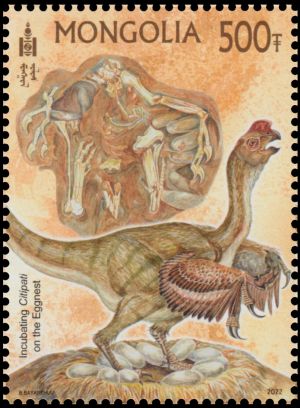 |
| Incubating Citipati on the eggnest on stamp of Mongolia 2022, MiNr.: , Scott: . |
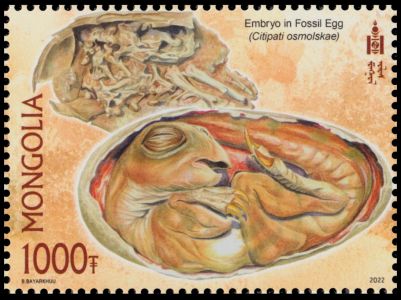 |
| Embryo of Citipati osmolskae on stamp of Mongolia 2022, MiNr.: , Scott: . |
Fittingly the Citipati are usually portrayed as a pair of dancing skeletons surrounded by a halo of flames.
This dinosaur was among the largest oviraptorids; it is estimated to have been around 2.9 meters in length and to have weighed 75–83 kg.
It is mainly known from the Ukhaa Tolgod locality at the Djadokhta Formation, where the first remains were collected during the 1990s. The genus and type species Citipati osmolskae was named and described in 2001. The specific name is in honour of Mrs. Halszka Osmólska, Polish paleontologist who had specialized in Mongolian dinosaurs, one of the leaders of the Polish–Mongolian Expeditions of the 1960s and 70s, which excavated so many important Gobi Desert dinosaurs.
Citipati is one of the best-known oviraptorids thanks to a number of well-preserved specimens, including individuals found in brooding positions atop nests of eggs, though most of them were initially referred to the related Oviraptor. These nesting specimens have helped to solidify the link between non-avian dinosaurs and birds.
In 1993 joint the Mongolian Academy of Sciences and American Museum of Natural History paleontological expedition discovered locality Ukhaa Tolgod the highly fossiliferous Djadokhta Formation, Gobi Desert. The site become one of the most important Late Cretaceous dinosaur localities in the world.
The dune sand at Ukhaa Tolgod contain some clay that absorb water instead of draining quickly as is true of most sandy soils. As the sand dunes absorbed more and more water, they eventually went past a critical point, becoming unstable and collapsing into a sandy, liquid river. This sand river was what entombed the animals at Ukhaa Tolgod and preserved them in very good conditions during millions of years.
One of the first important discoveries made by the expedition on the site was a small fossilized oviraptorid embryo, labelled as specimen IGM 100/971 (see below). At the time this was the first theropod dinosaur embryo known.The oviraptorid embryo is composed of a nearly complete skeleton and was found in a badly weathered semi-circular nest, which also included two perinate (hatchlings or embryos close to hatching) skulls less than 5 cm (50 mm) of an unknown dromaeosaurid taxon. One of these skulls was reported to preserve portions of an eggshell.
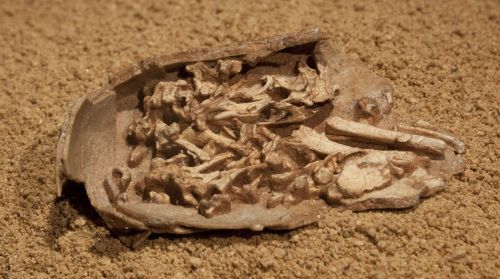 |
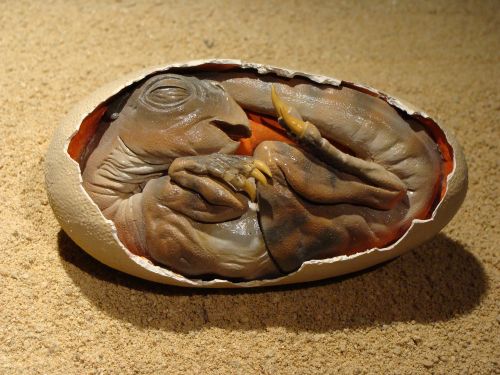 |
| Photograph of an embryo fossil of Citipati osmolskae, specimen IGM 100/971, at the American Museum of Natural History in New York. Image credit Wikipedia | Reconstruction of an embryo fossil of Citipati osmolskae, specimen IGM 100/971 Image credit Wikipedia |
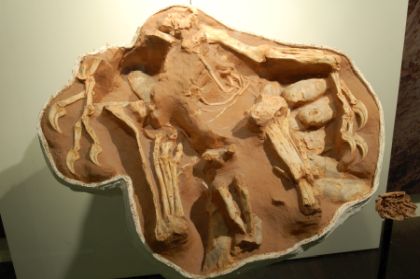 |
| Photograph of a nesting oviraptorid dinosaur Citipati osmolskae, specimen IGM 100/979 (nicknamed "Big Mamma"), at the American Museum of Natural History in New York. Image credit Wikipedia |
The eggs are similar in size, shape, and ornamentation to another egg from this locality in which an oviraptorid embryo is preserved (see above), suggesting that the nest is of the same species as the adult skeleton overlying it and was parented by the adult.
The skeleton is positioned over the center of the nest, with both hind limbs tightly folded and the feet and lower legs almost parallel each other.
The lack of disturbance to the nest and skeleton indicate that the specimen is preserved in the position in which the adult died.
At least 15 eggs are preserved, each one is about 16 centimetres long and 6-7 centimetres wide. The eggs arranged in pairs in the circular pattern.
It has been found that oviraptorid dinosaurs, similar to crocodiles, had two functional oviducts, therefore it is reasonable to assume that two legs were laid at the same time, placed side by side.
Its posture is the same as that commonly taken only by birds among tetrapods that brood their nest, and its close proximity to the eggs indicates that the nest was not covered, indicating that the behaviour of sitting on open nests in this posture evolved before the most recent common ancestor of modern birds.
The nesting position of Citipati also supports the hypothesis that it and other oviraptorids had feathered forelimbs.
The specimen shortly became famous and was nicknamed as "Big Mama" by The New York Times press. There are, however, no indication on the sex of the dinosaur. By some modern birds, both males and females usually take turns sitting on the eggs, therefore this fossil could have been "Big Papa" too.
 |
| A schematic interpretation of the “Big Mama” nesting Citipati osmolskae specimen (IGM 100/979) The preserved portion of the skeleton is shaded darker than the reconstructed portion. Image credit "An oviraptorid skeleton from the late Cretaceous of Ukhaa Tolgod, Mongolia, preserved in an avianlike brooding position over an oviraptorid nest". American Museum novitates ; no. 3265 |
Deinocheirus mirificus [R4]
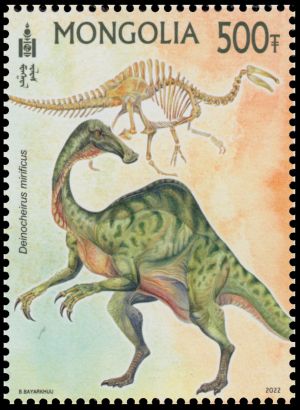 |
| Deinocheirus mirificus on stamp of Mongolia 2022, MiNr.: , Scott: . |
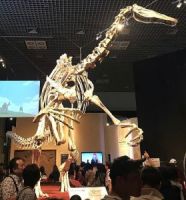 |
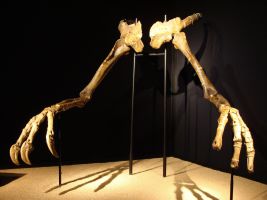 |
| Skeleton and arms of Deinocheirus mirificus, Image credit: Wikipedia. | |
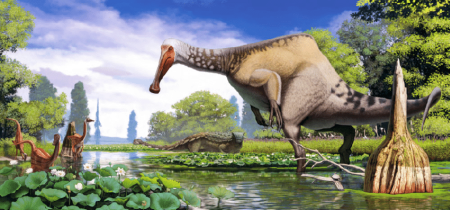 |
|
| Reconstruction of Deinocheirus mirificus, Image credit: The Expanding Earth: Indisputable Evidences of the Gobi Desert. | |
The legs were relatively short, and bore blunt claws. Its vertebrae had tall neural spines that formed a "sail" along its back. Most of the vertebrae and some other bones were highly pneumatisized by air sacs.
The tail ended in pygostyle-like vertebrae, which indicate the presence of a fan of feathers. The skull was 1.024 meter long, with a wide bill and a deep lower jaw, similar to those of hadrosaurs.
Deinocheirus is thought to have been omnivorous, as its skull shape indicates a diet of plants, fish scales were found in association with one specimen and gastroliths were also present in the stomach region of the specimen. The large claws may have been used for digging and gathering plants.
The first known fossil remains of Deinocheirus, a pair of large arms, shoulder girdles, and a few other bones, were discovered by Polish palaeontologist Zofia Kielan-Jaworowska, from the Polish-Mongolian Paleontological expedition (1963-1965), on July 9, 1965, at the Altan Ula III site in the Nemegt Basin of the Gobi Desert.
In 1970, this specimen became the holotype of the only species within the genus, Deinocheirus mirificus; the genus name is Greek for "horrible hand".
No further remains were discovered for almost fifty years, and its nature remained a mystery.
Two more complete specimens were described in 2014, which shed light on many aspects of the animal. Parts of these new specimens had been looted from Mongolia some years before, but were repatriated in 2014.
In 2021, the skeleton of Deinocheirus mirificus was printed on a margin of "100 years of modern science" Souvenir Sheet of Mongolia.
Gobihadros mongoliensis [R5]
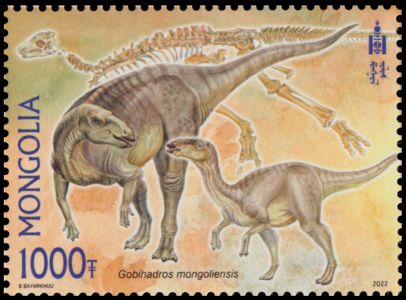 |
| Gobihadros mongoliensis on stamp of Mongolia 2022, MiNr.: , Scott: . |
It contains only the type species Gobihadros mongoliensis. It has an estimated length of 7.5 meters.
Between 1993 and 2004, the Mongolian Palaeontological Center and the Japanese Hayashibara Museum of Natural Sciences excavated sites at Bayshin Tsav.
In 2019, the type specimen of Gobihadros mongoliensis was described and the species name proposed by a group of international paleontologists.
The generic name combines references to the Gobi Desert and the Hadrosauroidea. The specific name refers to the provenance from Mongolia.
The Fighting Dinosaurs [R6]
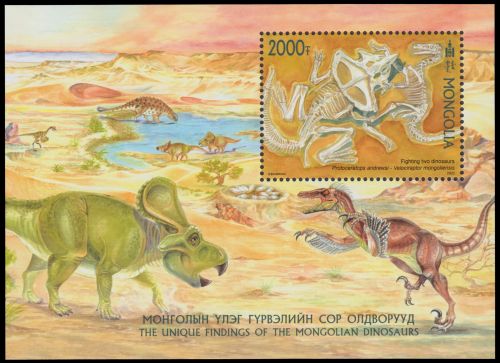 |
| The Fighting Dinosaurs on Souvenir-Sheet of Mongolia 2022, MiNr.: , Scott: . |
It preserves a Protoceratops andrewsi and Velociraptor mongoliensis trapped in combat and provides direct evidence of predatory behavior in non-avian dinosaurs.
Apparently locked in combat, these two fighting dinosaurs were remarkably preserved in this action pose some 80 million years ago.
Velociraptor was a fierce carnivore that hunted prey animals, such as the plant-eating Protoceratops (boar-sized, hornless cousin of Triceratops). Here, the Velociraptor has embedded its deadly foot claw into the neck of the crouching Protoceratops, near the region that housed the blood supply for the head.
(Unlike in "Jurassic Park" movie, Velociraptor was about as tall as a turkey, with estimated weight of about 15 kilograms.)
In turn, the Protoceratops appears to have bitten and broken the right arm of the Velociraptor, whose left hand grips the head of the Protoceratops.
The specimen was discovered in 1971 by Polish-Mongolian paleontological expeditions in the Gobi desert and has caused much debate as to how both animals came to be preserved together with relative completeness.
Multiple hypotheses have been proposed, including a drowning scenario, burial by either dune collapse or sandstorm, or alternatively they were not buried simultaneously.
| 3D reconstruction of The Fighting Dinosaurs fossil. | The story of the Fighting Dinosaurs |
Another dinosaur to mention is Ankylosaur, who is shown on the background of the Souvenir-Sheet and a cachet of one of the FDC. The Ankylosaurus is most likely is Tarchia tumanovae [R7]
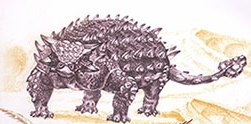 |
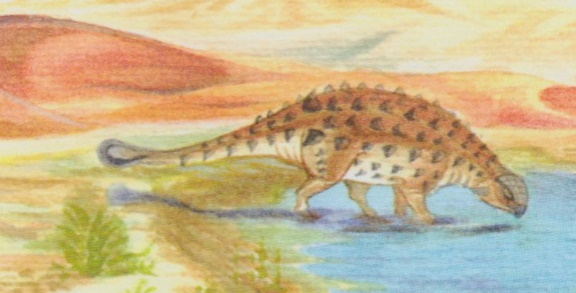 |
| Ankylosaurus on the cachet of FDC and the background of Souvenir-Sheet of Mongolia 2022. | |
Ankylosaurid dinosaurs, one group of Ankylosauria, are quadrupedal, herbivorous and have a heavily ornamented skull and parasagittal rows of osteoderms covering the dorsolateral surfaces of the body.
In 1970, a Polish-Mongolian expedition discovered an ankylosaurian skull near Khulsan. In 1977, Teresa Maryańska named and described the type species Tarchia kielanae.The generic name is derived from Mongolian tarkhi, "brain" and Latin ~ia, in reference to a brain size presumed larger than that of the related form Saichania.
The specific name honours Professor Zofia Kielan-Jaworowska, the leader of the expedition.
Tarchia is the geologically youngest of all known Asian ankylosaurid dinosaurs and is the longest known Asian ankylosaur, with an estimated body length of 8 meters. The rocks in which Tarchia fossils were found likely represent eolian dunes and interdune environments, with small intermittent lakes and seasonal streams. Hence, we know that Tarchia was a desert animal. If Tarchia had lived in well-watered forests, it would have had to contest with Tarbosaurus.
Products
| Stamps (perforated and imperforated) | ||
| Souvenir-Sheets | Mini-Sheets | |
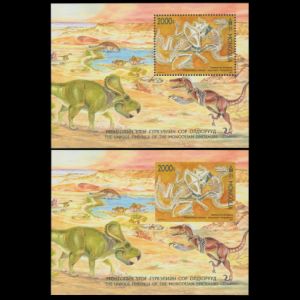 |
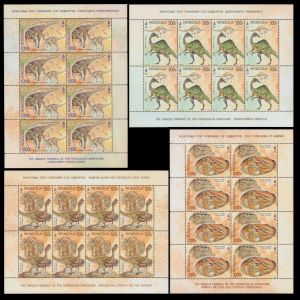 |
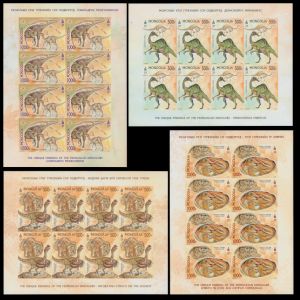 |
| FDC | ||
| Clean | Circulated | Reverse side |
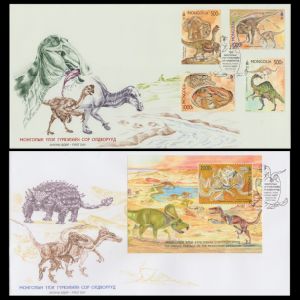 |
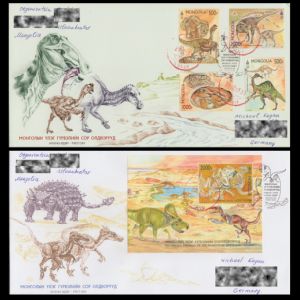 |
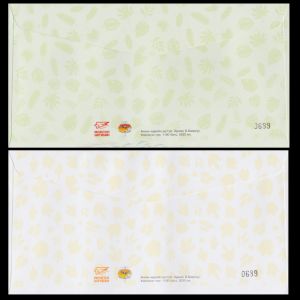 |
| Some examples of Circuated Covers | ||
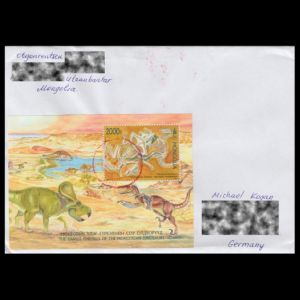 |
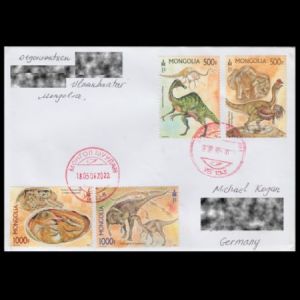 |
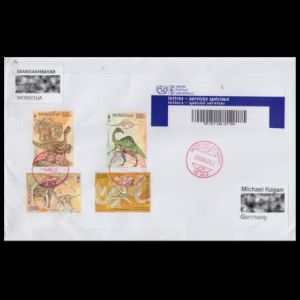 |
References:
- [R1] Technical details and stamps presentation: Information fyer, online store of Mongolian post: [1], [2], [3], montsame.mn.
- [R2] The history of Paleontological discoveries in Mongolia:
amicusmongolia,
"The Russian-Mongolian expeditions and research in vertebrate palaeontology" by Evgenii N. Kurochkin and Rinchen Barsbold,
List of dinosaurs discovered in Mongolia: NHM in London, - [R3] Citipati:
- Wikipedia
- "The World of Dinosaurs", by Mark A. Norell. ISBN-13: 978-0-226-62272-9
- "Locked in Time: Animal Behavior Unearthed in 50 Extraordinary Fossils", by Dean R. Lomax and Robert Nicholls. ISBN: 0231197284
- "An oviraptorid skeleton from the late Cretaceous of Ukhaa Tolgod, Mongolia, preserved in an avianlike brooding position over an oviraptorid nest". American Museum novitates ; no. 3265
- [R4] Deinocheirus: Wikipedia, National Geographic.
- [R5] Gobihadros: Wikipedia, sci-news, everything dinosaur,
- [R6] The Fighting Dinosaurs:
Wikipedia,
elementy.ru (in Russian),
AMNH,
"Locked in Time: Animal Behavior Unearthed in 50 Extraordinary Fossils", by Dean R. Lomax and Robert Nicholls. ISBN: 0231197284 . - [R7] Tarchia tumanovae: Wikipedia, Nature,
Acknowledgement:
Many thanks to Dr. Peter Voice from Department of Geological and Environmental Sciences, Western Michigan University, for the draft page review and his valuable comments.
| <prev | back to index | next> |
